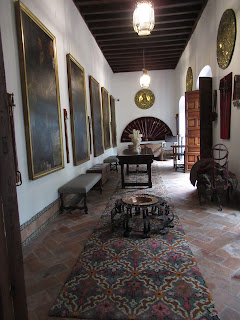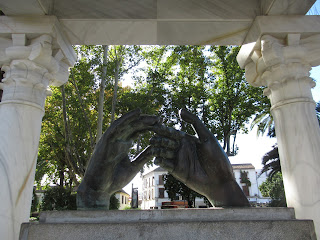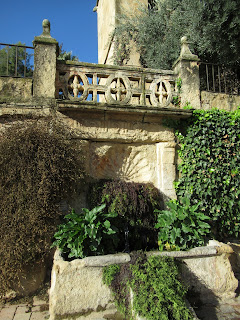On our way to visiting the palace in Cordoba, we stumbled on the remains of the magnificent marble Templo Romano, which was discovered in the 1950s during the expansion of City Hall. It wasn't the only temple that the city had, but it was possibly the most important of all. After reading about it in wikipedia, I learned that it was built during the second half of the 1st century during the reign of Emperor Claudius and was completed forty years later, during the reign of Emperor Domitian.
The Courtyard of the Bars, created in the 17th century during the era of the Third Lord of Villaseca, could be seen from outside the three grand bars. The purpose was to exhibit the owners' prestige and power. Highlights included the wonderful citrus trees on trellises and the wonderful pots of knapweed.
The 400 year old, white oak tree was part of The Garden created at the beginning of the 19th century by the 7th Marquis of Villaseca who wanted the palace to have a garden in keeping with the fashion of other noble families of that time.
I couldn't believe we were seeing English-language Black Friday signs in Cordoba of all places.
These Hebrew inscriptions referred to the founder of the synagogue and the date of its construction. Others were nearly all from the Bible's Book of Psalms.
We stopped for a few minutes to explore the exterior of San Andres Church and its interesting courtyard, even though the weather was again rather nasty.
After seeing several very grand palaces already in Spain, I was surprised that the Viana Palace, formerly known as the Rejas de Don Gome Palace in honor of its first owner, didn't look terribly prepossessing from the street. However, I'd read in my research of Cordoba that the stately home was unlike any other as it housed the finest collection of courtyards in Cordoba and was declared a National Monument of Historical and Artistic Interest in 1980.
Between the 15th century and the end of the 20th century, the Viana Palace had 18 owners who all belonged to noble families. The palace was an incredible 70,000 square feet including its many courtyards and gardens.
The configuration of the 16th century Reception Courtyard dated from the era of the Second Lord of Villaseca who transformed the medieval house into a Renaissance mansion to show off his family's socio-economic status. It had no columns in the entry to allow for the easier entrance and exit of carriages.
I loved the courtyard's intricate rock designs that looked like sisal rugs.
There was such harmony between the architecture and landscaping that it all flowed perfectly.
The tiny Courtyard of the Cats was the oldest documented neighborhood courtyard in Cordoba. It was a rental property and service patio until the middle of the 18th century.
The Courtyard of the Oranges, located just off the kitchen, was part of the original heart of the palace in the 15th century and was the entry to the palace until the Reception Courtyard was built. The brochure indicated it brought to mind Hispanic-Arab gardens because of its closed design, intimate ambiance, the role of water and the use of both flowers and fruit trees.
What I found so intriguing was that the courtyards led directly from one to the next to the next thru small openings in tall hedges or gates. The Courtyard of the Madama was created as part of the reforms that took place during the 18th century. Unlike the others, it was designed to be seen from the inside of the palace. The cypress plant structure that surrounded the sweet nymph fountain was added at the beginning of the 20th century. The wrought iron balcony, the blue windows and the walls landscaped with creepers gave a hint of color and scent to the courtyard.
We could hear nearby church bells pealing while admiring the garden and its 100-year old trees.
The largest and most modern courtyard in the complex was the Courtyard of the Columns which was constructed in the 1980s to give Viana a place to hold events and celebrations once the palace was opened to the public. It was lovely seeing all the pots of fall mums, something my own Mum surely would have loved.
An image I will always hold dear is that of flowering pots on walls throughout Cordoba.
The 400 year old, white oak tree was part of The Garden created at the beginning of the 19th century by the 7th Marquis of Villaseca who wanted the palace to have a garden in keeping with the fashion of other noble families of that time.
The romantic pergola was covered with ivy. Ivy: You'd have loved it and also having the chance to paint there!
The Courtyard of the Pool, formerly known as the Courtyard of the Greenhouse and the Courtyard of the Deer, was a typical working courtyard and served as the nerve center of the palace's gardening team. The water in the pool came from the well and was used to water plants, not for swimming! In 1960, the greenhouse, an uncommon component of courtyards then, was used to grow seedlings for spring pots.
Everything in the Courtyard of the Well, originally part of the Courtyard of the Pool, revolved around the simple and ancient well which used to have buckets used with an old wheel. The water, from the underground Colodro Stream, supplies all the palace's courtyards and fountains.
The Courtyard of the Gardeners aka The Vertical Garden was so named because it housed the equipment for the gardening team. Part of the Pool-Well-Garden trio, it was also known for some reason as the Courtyard of the Dogs. The most striking feature was its vertical garden and its plumbago-covered wall, identical to that in the well courtyard. Also very appealing were the archaeological objects and tiles that adorned the courtyard, added in the 20th century to give it a more stately atmosphere.
The Courtyard of the Chapel dated to the 17th century when it was part of adjacent homes but it became part of Viana in the 19th century. The name came from the existence of an annexed chapel. According to the information, "the cool shade provided by the canopy of citrus plants and its architectural composition helped to create an air of calm and introspection."
The interior had outstanding salons that housed the wealthy owner's treasures, notably paintings, clocks, tapestries, weapons, furniture and porcelain collections.
Despite the 'Palacio' in its name, Viana wasn't a home for royalty, but for a succession of very rich families who over four centuries, kept adding to the house by buying up their neighbors’ adjoining properties. It was such a joy going through the garden and dozen courtyards - or patios as the Spanish call them - and be taken by surprise how each one differed from the others, in design, use and sentiment. It was so refreshing that the courtyards and the home were on a very human scale, unlike the royal palaces we'd recently seen. Plus, the luxury of touring the patios and home with only a handful of other visitors and spending a paltry five euros each added to our delight!
Just like the last couple of days in Cordoba, we were delighted to be able to pop our heads into this and other open wooden doors to view the picture-perfect patios behind the locked inner gates as the owners have no problem sharing them with tourists. Patios, a common feature throughout Andalusia, functioned as a quiet outdoor living room and an oasis from the heat for the Romans and the Moors added lush, decorative touches.
Walking through Cordoba's old town was like a walk back in time until we saw the occasional car trying to make its way along narrow lanes and maneuver around tight corners!
We'd seen so much of old Cordoba, it was a welcome change walking through the modern city, starting with the Christmas Market in the Art Deco-styled Plaza de las Tendillas.
We decided to return to the city's Synagogue in the old town as it was closed the day before. The small but beautifully preserved place of worship was built between 1314 and 1315 and, as I mentioned in the previous post, was in use until the final exclusion of Jews in 1492.
The synagogue was built by Mudejar craftsmen during a period of religious tolerance after the Christian Reconquista of Cordoba in 1236, i.e. when the Christians regained controlled of the city from the Muslim Moors. Cordoba's sizable Jewish community was welcomed in the city during Muslim times, although its members were required to pay substantial taxes.
It was hard to comprehend it was the only preserved synagogue in Andalusia and one of just three left in Spain. We'd been fortunate to see the others in Toledo while on a day trip from Madrid. After the Jews were expelled, the synagogue was successively used as a hospital, a shoemakers' guild and finally a church. As its old roof was falling apart, its paneling was replaced. When part of the mortared walls fell down in 1884, a priest discovered the remarkable walled plaster work. A year later, it was declared a national monument and restoration began.
These Hebrew inscriptions referred to the founder of the synagogue and the date of its construction. Others were nearly all from the Bible's Book of Psalms.
The rich Mudejar decorations of intertwined flowers, arabesques and Stars of David were just spectacular. We were both so appreciative the synagogue was open this time.
On our first day, we'd seen this pretty gazebo when it was drizzly so hadn't really stopped to admire it. How much prettier it was against the backdrop of a bright blue sky and with the sun shining!
Since it turned out to be a beautiful afternoon, we wandered over to the Alcazar, the Cordoban version of the much more famous Alcazar in Seville. It looked pretty darned fabulous against the brilliant blue sky and palm trees, even if it was rather insignificant by comparison.
The fortress, known as the Castle of the Christian Monarchs, was built along the city's Roman walls during its Visigothic period. After King Ferdinand and Queen Isabella donated the castle to the Spanish Inquisition in 1482, it played a key role in the Catholic church's effort to discover 'false converts to Christianity' - mostly Jews who had decided not to flee Spain in 1492.
The castle or fortress was a gorgeous place to photograph in the late afternoon sun as was the special man below!
We couldn't remember the last time we'd seen such a bright blue sky, no wonder we were both smiling so much! In six years of traveling overseas, this was certainly our 'worst' trip by far in terms of lousy weather.
It was strange that so few of the rooms had any furniture or objects because of the castle's constant reuse and recycling. This was a Roman sarcophagus from the 3rd century. I wonder where it had come from before it ended up here!
It was a shame the window's reflection marred the photo of this exquisite geometric 2nd century Roman mosaic as it was just unbelievable.
The center of this mosaic depicted Medusa, one of the most popular monsters of Greek mythology.
Many of the rooms had rolled-up sisal blinds.
We returned outside just as the clouds rolled in. The sun didn't last long but we were still more than content having seen a blue sky for a bit.
Cute fish mosaics decorated the bottom of some of the pools.
The statue showed Christopher Columbus meeting with Ferdinand and Isabella before he left for America in 1492.
Most of the cedar trees were bound by wire so they couldn't spread. This was a 'hairy' cedar in need of a trim!
Never had I seen bushes trimmed to look like large pots, complete with handles!
This tree was trimmed to resemble one of the castle towers - certainly another first!
We were so lucky to see scads of flowers blooming in late November, thanks to being in southern Spain.
Per your request or suggestion, Janina and Suellen, here are photos of the studio apartment we stayed in for three nights in Cordoba! Initially, the apartment looked like the epitome of perfection with very attractive brick walls, lovely thick towels and a well equipped kitchen and pretty bathroom. It was only after spending a few hours there that we noticed the bathroom plaster peeled badly after taking a shower, the included daily breakfast consisted of rather stale pastries by the third morning, there was no place by the couch to place a cup of tea, etc. If only apartment hosts would stay in their rented apartments for a few days so they would then realize what was amiss and then work out the kinks!
I don't want to end on a down note as Steven and I had a wonderful time discovering Cordoba with its glorious Roman and Moorish past, the splendid Mezquita and its mosque cum church, the fantastic patios and whitewashed buildings in the old town, its compelling Jewish Quarter and the Palacio Viana's beautiful courtyards.
Next post: Gracious Granada.
Posted on January 29th, 2019, from snowy and sunny Littleton!










































































































Muy bonita! Muchas gracias, Annie!
ReplyDeleteMuchas gracias a ti tambien, Andrew!
DeleteAs I was viewing the beautiful patio/gardens my mind turned to the work to just water all of them. What a job!! But, very lovely. Janina
ReplyDeleteI must admit I didn't think of the watering needs, Janina, until I saw your comment. Good point but, as you said, the patios and gardens were sublime.
DeleteAnnie